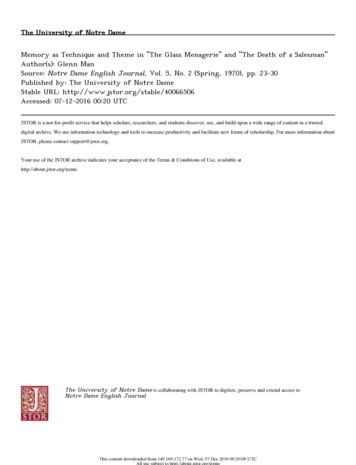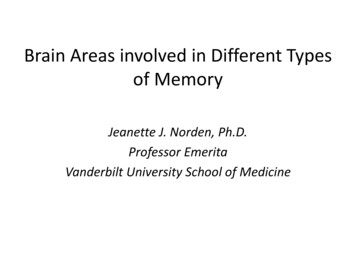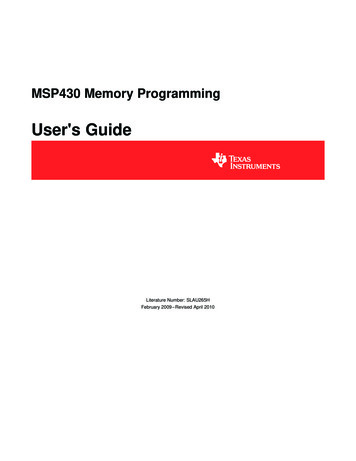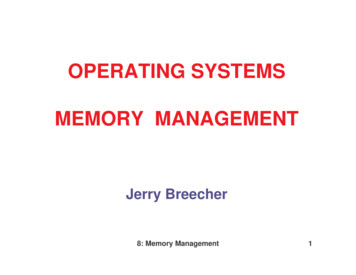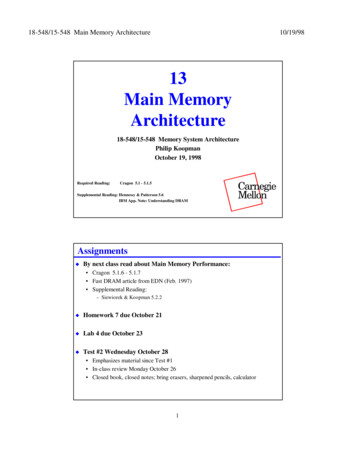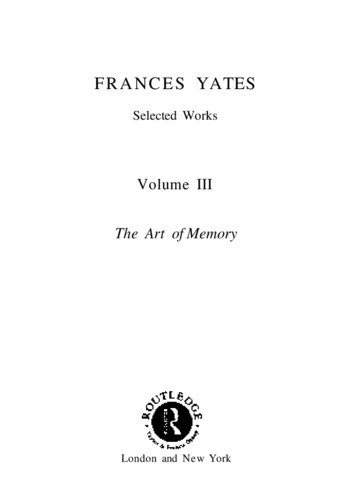
Transcription
F R A N C E S YATESSelected WorksVolume IIIThe Art of MemoryLondon and New York
F R A N C E S YATESSelected WorksVOLUME IThe Valois TapestriesV O L U M E IIGiordano Bruno and the Hermetic TraditionV O L U M E IIIThe Art of MemoryV O L U M E IVThe Rosicrucian EnlightenmentVOLUME VAstraeaV O L U M E VIShakespeare's Last PlaysV O L U M E VIIThe Occult Philosophy in the Elizabethan AgeV O L U M E VIIILull and BrunoV O L U M E IXRenaissance and Reform: The Italian ContributionVOLUME XIdeas and Ideals in the North European Renaissance
First published 1966 by Routledge & Kcgan PaulReprinted by Routledge 199911 New Fetter LaneLondon EC4I' 4EESimultaneously published in the USA and Canadaby Routledge29 West 35th Street, New York, NY 10001Routledge is an imprint of the Taylor & Francis Croup 1966 Frances A. YatesPrinted and bound in Great Britain by Antony Rowe Ltd,Chippenham, WiltshirePublisher's noteThe publisher has gone to great lengths to ensure thequality of this reprint but points out that some imperfectionsin the original book may be apparent.British Library Cataloguing in Publication DataA CIP record of this set is available from the British LibraryLibrary of Congress Cataloging in Publication DataA catalogue record for this book has been requestedISBN 0-415-22046-7 (Volume 3)10 Volumes: ISBN 0-415-22043-2 (Set)
Hermetic Silence. From Achilles Bocchius, Symbolicarumquaestionum . . . libri quinque, Bologna, 1555. Engraved by G. Bonasone(p. 170)
FRANCES A.YATESTHE ART OF MEMORYARK PAPERBACKSLondon, Melbourne and Henley
First published in 1966ARK Edition 1984ARK PAPERBACKS is an imprint ofRoutledgc & Kcgan Paul plc14 Leicester Square, London WC2II 7PH, Kngland.464 St. Kilda Road, Melbourne,Victoria 3004, Australia andBroadway House, Newtown Road,Henley-on-Thames, Oxon RG9 1EN, Kngland.Printed and bound in Great Britain byThe Guernsey Press Co. Ltd.,Guernsey, Channel Islands. Frances A. Yates 1966.No part of this book may be reproduced inany form without permission from thepublisher, except for the quotation of briefpassages in criticism.ISBN 0-7448-0020-X
CONTENTSPrefacepageI. The Three Latin Sources for the Classical Artof MemoryII. The Art of Memory in Greece: Memory andthe SoulIII. The Art of Memory in the Middle Agesxii2750IV. Mediaeval Memory and the Formation ofImagery82V. The Memory Treatises105VI. Renaissance Memory: The Memory Theatre ofGiulio Camillo129VII. Camillo's Theatre and the Venetian Renaissance160VIII. Lullism as an Art of MemoryIX. Giordano Bruno: The Secret of ShadowsX. Ramism as an Art of MemoryXI. Giordano Bruno: The Secret of SealsXII. Conflict between Brunian and Ramist MemoryXIII. Giordano Bruno: Last Works on Memory173199231243266287XIV. The Art of Memory and Bruno's ItalianDialogues308XV. The Theatre Memory System of Robert Fludd 320XVI. Fludd's Memory Theatre and the GlobeTheatre342XVII. The Art of Memory and the Growth of Scientific Method368Index390
ILLUSTRATIONSPLATESHermetic Silence. From Achilles Boccbius,Symbolicarum quaestionum . . libri quinque,Bologna, 1555. Engraved by G. Bonasonefrontispiece1. The Wisdom of Thomas Aquinas. Fresco by Andrea daFirenze, Chapter House of Santa Maria Novella,Florence (photo: Alinari)facing page 802. Justice and Peace. Fresco by Ambrogio Lorenzetti(Detail), Palazzo Pubblico, Siena {photo: Alinari)813. (a) Charity(b) EnvyFrescoes by Giotto, Arena Capella, Padua (photos:Alinari)964. (a) Temperance, Prudence(b) Justice, FortitudeFrom a Fourteenth-Century Italian Manuscript,Vienna National Library (MS. 2639)(c) Penance, From a Fifteenth-Century German Manuscript, Biblioteca Casanatense, Rome (MS. 1404)975. (a) Abbey Memory System(b) Images to be used in the Abbey Memory System.From Johannes Romberch, Congestorium artificioseMemorie, ed. of Venice, 15331126. (a) Grammar as a Memory Image(b) and (c) Visual Alphabets used for the Inscriptionson GrammarFrom Johannes Romberch, Congestorium ArtificioseMemorie,ed.ofVenice,15331137. (a) Hell as Artificial Memory(b) Paradise as Artificial MemoryFrom Cosmas Rossellius, Thesaurus Artificiosae Memoriae, Venice, 1579128vii
ILLUSTRATIONS8. (a) The Places of Hell. Fresco by Nardo di Cione(Detail), Santa Maria Novella, Florence (photo:Alinari)(b) Titian, Allegory of Prudence (Swiss ownership)facing page 1299. (a) Palladio's Reconstruction of the Roman Theatre.From Vitruvius, De architectura cum commentariisDanielis Barbari, ed. of Venice, 1567(b) The Teatro Olimpico, Vicenza (photo: Alinari)19210. Ramon Lull with the Ladders of his Art. FourteenthCentury Miniature, Karlsruhe (Cod. St Peter 92)19311. Memory System from Giordano Bruno's De umbrisidearum (Shadows), Paris, 158220812. (a) Images of the Decans of Aries(b) Images of the Decans of Taurus and GeminiFrom Giordano Bruno, De umbris idearum (Shadows),ed. of Naples, 188620913- (a), (b), (c), (d), (e), and (f)Pictures Illustrating the Principles of the Art ofMemory. From Agostino del Riccio, Arte della memorialocale, 1595, Biblioteca Nazionale, Florence (MS. II,I, 13)32014. (a) The Heaven(b) The Potter's Wheel'Seals' from Bruno's Triginta Sigilli etc.(c) Memory System from Bruno's Figuratio Aristoteliciphysici auditus, Paris, 1586(d) Memory System from Bruno's De imaginumcompositione, Frankfort, 159132115. First page of the Ars memoriae in Robert Fludd'sUtriusque Cosmi. Historia, Tomus Secundus, Oppenheim, 161933616. The Zodiac. From Robert Fludd's Ars memoriae33617. The Theatre. From Robert Fludd's Ars memoriae33718. (a) Secondary Theatre(b) Secondary TheatreFrom Robert Fludd's Ars memoriae33719. The De Witt Sketch of the Swan Theatre. Library ofthe University of Utrecht35220. Sketch of the Stage of the Globe Theatre based onFludd353viii
ILLUSTRATIONSFIGURES1. The Spheres of the Universe as a Memory System.From J. Publicius, Oratoriae artis epitome, 1482 page 1112. The Spheres of the Universe as a Memory System.From J. Romberch, Congestorium artificiose memorie,ed. of 15331163. Human Image on a Memory Locus. From Romberch,Congestorium artificiose memorie, ed. of 15331184. The Ladder of Ascent and Descent. From RamonLull's Liber de ascensu et descensu intellectus, ed. ofValencia, 15121805. 'A' Figure. From R. Lull's Ars brevis (Opera, Strasburg, 1617)1826. Combinatory Figure. From Lull's Ars brevis1837. Tree Diagram. From Lull's Arbor scientiae, ed. ofLyons, 15151868. Memory Wheels. From G. Bruno, De umbris idearum,15822099. Diagram of Faculty Psychology. Redrawn from a diagram in Romberch, Congestorium artificiose memorie 25610. Memory Theatre or Repository. From J. Willis,Mnemonica, 161833711. Suggested Plan of the Globe Theatre358Folder: The Memory Theatre of Giulio Camillobetween pages 144-5ix
PREFACETHE subject of this book will be unfamiliar to most readers. Fewpeople know that the Greeks, who invented many arts, invented anart of memory which, like their other arts, was passed on to Romewhence it descended in the European tradition. This art seeks tomemorise through a technique of impressing 'places' and 'images'on memory. It has usually been classed as 'mnemotechnics', whichin modern times seems a rather unimportant branch of humanactivity. But in the ages before printing a trained memory wasvitally important; and the manipulation of images in memory mustalways to some extent involve the psyche as a whole. Moreover anart which uses contemporary architecture for its memory placesand contemporary imagery for its images will have its classical,Gothic, and Renaissance periods, like the other arts. Though themnemotechnical side of the art is always present, both in antiquityand thereafter, and forms the factual basis for its investigation, theexploration of it must include more than the history of its techniques. Mnemosyne, said the Greeks, is the mother of the Muses;the history of the training of this most fundamental and elusive ofhuman powers will plunge us into deep waters.My interest in the subject began about fifteen years ago when Ihopefully set out to try to understand Giordano Bruno's works onmemory. The memory system excavated from Bruno's Shadows(P1. II) was first displayed in a lecture at the Warburg Institute inMay, 1952. Two years later, in January, 1955, the plan of GiulioCamillo's Memory Theatre (see Folder) was exhibited, also at alecture at the Warburg Institute. I had realised by this time thatthere was some historical connection between Camillo's Theatre,Bruno's and Campanella's systems, and Robert Fludd's Theatresystem, all of which were compared, very superficially, at thislecture. Encouraged by what seemed a slight progress, I began towrite the history of the art of memory from Simonides onwards.This stage was reflected in an article on 'The Ciceronian Art ofMemory' .which was published in Italy in the volume of studies inhonour of Bruno Nardi (Medioevo e Rinascimento, Florence,1955).xi
PREFACEAfter this there was a rather long halt, caused by a difficulty. Icould not understand what happened to the art of memory in theMiddle Ages. Why did Albertus Magnus and Thomas Aquinasregard the use in memory of the places and images of Tullius' as amoral and religious duty ? The word 'mnemotechnics' seemed inadequate to cover the scholastic recommendation of the art ofmemory as a part of the cardinal virtue of prudence. Gradually theidea began to dawn that the Middle Ages might think of figures ofvirtues and vices as memory images, formed according to the classical rules, or of the divisions of Dante's Hell as memory places.Attempts to tackle the mediaeval transformation of the classicalart were made in lectures on 'The Classical Art of Memory in theMiddle Ages' given to the Oxford Mediaeval Society in March,1958, and on 'Rhetoric and the Art of Memory' at the WarburgInstitute in December 1959. Parts of these lectures are incorporated in chapters IV and V.The greatest problem of all remained, the problem of theRenaissance magical or occult memory systems. Why, when theinvention of printing seemed to have made the great Gothicartificial memories of the Middle Ages no longer necessary, wasthere this recrudescence of the interest in the art of memory in thestrange forms in which we find it in the Renaissance systems ofCamillo, Bruno, and Fludd ? I returned to the study of GiulioCamillo's Memory Theatre and realised that the stimulus behindRenaissance occult memory was the Renaissance Hermetic tradition. It also became apparent that it would be necessary to write abook on this tradition before one could tackle the Renaissancememory systems. The Renaissance chapters in this book dependfor their background on my Giordano Bruno amd the HermeticTradition (London and Chicago, 1964).I had thought that it might have been possible to keep Lullismout of this book and treat it separately, but it soon becameclear that this was impossible. Though Lullism does not comeout of the rhetoric tradition, like the classical art of memory,and though its procedures are very different, yet it is, in oneof its aspects, an art of memory and as such it becomes conflatedand confused with the classical art at the Renaissance. Theinterpretation of Lullism given in chapter VIII is based on myarticles 'The Art of Ramon Lull: An Approach to it through Lull'sTheory of the Elements', and 'Ramon Lull and John Scotusxii
PREFACEErigena', Journal of the Warburg and Courtauld Institutes, XVII(1954) and XXIII (1960).There is no modern book in English on the history of the art ofmemory and very few books or articles on it in any language. WhenI began, my chief aids were some old monographs in German andthe later German studies by H. Hajdu, 1936, and L. Volkmann,1937 (for full references, see p. 105). In 1960, Paolo Rossi's Clavisuniversalis was published. This book, which is in Italian, is aserious historical study of the art of memory; it prints a good dealof source material, and contains discussions of Camillo's Theatre,of Bruno's works, of Lullism, and much else. It has been valuableto me, particularly for the seventeenth century, though it is onquite different lines from this book. I have also consulted Rossi'snumerous articles and one by Cesare Vasoli (references on pp. 105,184, 194). Other books which have particularly helped me areH. Caplan's edition of Ad Herennium (1954); W. S. Howell,Logic and Rhetoric in England, 1500-1700 (1956); W. J. Ong,Ramus; Method and the Decay of Dialogue (1958); Beryl Smalley,English Friars and Antiquity (i960).Though it uses a good deal of earlier work, this book in itspresent form is a new work, entirely rewritten and expanded infresh directions during the past two years. Much that was obscureseems to have fallen into better shape, particularly the connectionsof the art of memory with Lullism and Ramism and the emergenceof 'method'. Moreover what is perhaps one of the most excitingparts of the book has become prominent only quite recently.This is the realisation that Fludd's Theatre memory system canthrow light on Shakespeare's Globe Theatre. The imaginaryarchitecture of the art of memory has preserved the memoryof a real, but long vanished, building.Like my Giordano Bruno and the Hermetic Tradition, the presentbook is orientated towards placing Bruno in a historical context butalso aims at giving a survey of a whole tradition. It particularlyendeavours to throw light, through the history of memory, on thenature of the impact which Bruno may have made on ElizabethanEngland. I have tried to strike out a pathway through a vast subjectbut at every stage the picture which I have drawn needs to besupplemented orcorrected by further studies. This is animmenselyrich field for research, needing the collaboration of specialists inmany disciplines.xiii
PREFACENow that the Memory Book is at last ended, the memory of thelate Gertrud Bing seems more poignantly present than ever. In theearly days, she read and discussed my drafts, watching constantlyover my progress, or lack of progress, encouraging and discouraging by turns, ever stimulating with her intense interest and vigilantcriticism. She felt that the problems of the mental image, of theactivation of images, of the grasp of reality through images—problems ever present in the history of the art of memory—wereclose to those which preoccupied Aby Warburg, whom I onlyknew through her. Whether this book is what she hoped for I cannow never know. She did not see even the first three chapters of itwhich were about to be sent to her when she was taken ill. I dedicate it to her memory, with deep gratitude for her friendship.My debt to my colleagues and friends of the Warburg Institute,University of London, is, as always, profound. The Director, E. H.Gombrich, has always taken a stimulating interest in my laboursand much is owed to his wisdom. I believe that it was he who firstput into my hands L'ldea del Theatro of Giulio Camillo. Therehave been many invaluable discussions with D. P. Walkerwhose specialist knowledge of certain aspects of the Renaissancehas been of constant assistance. He read the early drafts andhas also read this book in manuscript, kindly checking some ofmy translations. With J. Trapp there have been talks about therhetoric tradition, and he has been a mine of bibliographicalinformation. Some iconographical problems were laid beforeL. Ettlinger.All the librarians have been endlessly patient with my efforts tofind books. And the staff of the photographic collection has shownsimilar forbearance with my efforts to find photographs.I am grateful for the comradeship of J. Hillgarth and R. PringMill in Lull studies. And to Elspeth Jaffe, who knows much aboutarts of memory, for past conversations.My sister, R. W. Yates, has read the chapters as they werewritten. Her reactions to them have been a most valuable guide andher clever advice of great help in revisions. With unfailing goodhumour she has given untiring assistance in countless ways. Shehas contributed above all to the plans and sketches. She drew theplan of Camillo's Theatre and the sketch of the Globe based onFludd. The suggested plan of the Globe is very largely her work.We shared together the excitement of the reconstruction of thexiv
PREFACEGlobe out of Fludd during memorable weeks of close collaboration.The book owes to her one of its greatest debts.I have constantly used the London Library to whose staff I amdeeply grateful. And it goes without saying that the same is true ofthe library of the British Museum and its staff. I am also indebtedto the librarians of the Bodleian Library, the Cambridge University Library, the library of Emmanuel College, Cambridge, and ofthe following libraries abroad: Biblioteca Nazionale, Florence;Biblioteca Ambrosiana, Milan; Bibliotheque Nationale, Paris;Biblioteca Vaticana, Rome; Biblioteca Marciana, Venice.I am indebted for their kind permissions to reproduce miniaturesor pictures in their possession to the Directors of the BibliotecaNazionale, Florence, of the Badische Landesbibliothek, Karlsruhe,of the Ostcrreichische Nationalbibliothek, Vienna, of the BibliotecaCasanatense, Rome, and the Swiss ownership of the picture byTitian.FRANCES A. YATESWarburg Institute,University of Londonxv
Chapter IT H E THREE LATIN SOURCESFOR THE CLASSICALART OF MEMORY 1banquet given by a nobleman of Thessaly namedScopas, the poet Simonides of Ceos chanted a lyricpoem in honour of his host but including a passage inpraise of Castor and Pollux. Scopas meanly told thepoet that he would only pay him half the sum agreed upon for thepanegyric and that he must obtain the balance from the twin godsto whom he had devoted half the poem. A little later, a message wasbrought in to Simonides that two young men were waiting outsidewho wished to see him. He rose from the banquet and went out butcould find no one. During his absence the roof of the banquetinghall fell in, crushing Scopas and all the guests to death beneath theruins; the corpses were so mangled that the relatives who came to1The English translations of the three Latin sources used are those inthe Loeb edition of the classics: die Ad Herennium is translated by H.Caplan; the De oratore by E. W. Sutton and H. Rackham; Quintilian'sInuitutio oratorio by H. E. Butler. When quoting from these translationsI have sometimes modified them in the direction of literalness, particularly in repeating the actual terminology of the mnemonic rather than inusing periphrases of the terms.The best account known to me of the art of memory in antiquity isthat given by H. Hajdu, Das Mnemotechnische Schriftum des Miitelalters,Vienna, 1936. I attempted a brief sketch of it in my article 'The Ciceronian Art of Memory' in Medioeve e Rinascimento, Studi in onore di BrunoNardi, Florence, 1955, II, pp. 871 ff. On the whole, the subject has beencuriously neglected.C—A.O.M.I
THREE LATIN SOURCES FOR THE CLASSICAL ART OF MEMORYtake them away for burial were unable to identify them. ButSimonides remembered the places at which they had been sittingat the table and was therefore able to indicate to the relatives whichwere their dead. The invisible callers, Castor and Pollux, hadhandsomely paid for their share in the panegyric by drawingSimonides away from the banquet just before the crash. And thisexperience suggested to the poet the principles of the art of memoryof which he is said to have been the inventor. Noting that it wasthrough his memory of the places at which the guests had beensitting that he had been able to identify the bodies, he realised thatorderly arrangement is essential for good memory.He inferred that persons desiring to train this faculty (of memory)must select places and form mental images of the things they wishto remember and store those images in the places, so that the orderof the places will preserve the order of the things, and the images ofthe things will denote the things themselves, and wc shall employthe places and images respectively as a wax writing-tablet and theletters written on it.2The vivid story of how Simonides invented the art of memory istold by Cicero in his De oratore when he is discussing memory asone of the five parts of rhetoric; the story introduces a brief description of the mnemonic of places and images (loci and imagines)which was used by the Roman rhetors. Two other descriptions ofthe classical mnemonic, besides the one given by Cicero, havecome down to us, both also in treatises on rhetoric when memoryas a part of rhetoric is being discussed; one is in the anonymousAd C. Herennium libri IV; the other is in Quintilian's Institutiooratorio.The first basic fact which the student of the history of the classical art of memory must remember is that the art belonged torhetoric as a technique by which the orator could improve hismemory, which would enable him to deliver long speeches frommemory with unfailing accuracy. And it was as a part of the art ofrhetoric that the art of memory travelled down through the European tradition in which it was never forgotten, or not forgottenuntil comparatively modern times, that those infallible guides inall human activities, the ancients, had laid down rules and preceptsfor improving the memory.2Cicero, De oratore, II, lxxxvi, 351-4.2
THREE LATIN SOURCES FOR THE CLASSICAL ART OF MEMORYIt is not difficult to get hold of the general principles of themnemonic. The first step was to imprint on the memory a seriesof loci or places. The commonest, though not the only, type ofmnemonic place system used was the architectural type. Theclearest description of the process is that given by Quintilian.3 Inorder to form a series of places in memory, he says, a building is tobe remembered, as spacious and varied a one as possible, the forecourt, the living room, bedrooms, and parlours, not omittingstatues and other ornaments with which the rooms are decorated.The images by which the speech is to be remembered—as anexample of these Quintilian says one may use an anchor or aweapon—are then placed in imagination on the places which havebeen memorised in the building. This done, as soon as the memoryof the facts requires to be revived, all these places are visited inturn and the various deposits demanded of their custodians. Wehave to think of the ancient orator as moving in imaginationthrough his memory building whilst he is making his speech, drawing from the memorised places the images he has placed on them.The method ensures that the points are remembered in the rightorder, since the order is fixed by the sequence of places in thebuilding. Quintilian's examples of the anchor and the weapon asimages may suggest that he had in mind a speech which dealt atone point with naval matters (the anchor), at another with militaryoperations (the weapon).There is no doubt that this method will work for anyone who isprepared to labour seriously at these mnemonic gymnastics. Ihave never attempted to do so myself but I have been told of aprofessor who used to amuse his students at parties by asking eachof them to name an object; one of them noted down all the objectsin the order in which they had been named. Later in the eveningthe professor would cause general amazement by repeating the listof objects in the right order. He performed his little memory featby placing the objects, as they were named, on the window sill, onthe desk, on the wastepaper basket, and so on. Then, as Quintilianadvises, he revisited those places in turn and demanded from themtheir deposits. He had never heard of the classical mnemonic buthad discovered his technique quite independently. Had he extended his efforts by attaching notions to the objects rememberedon the places he might have caused still greater amazement by3Institutio oratorio, XI, ii, 17-22.3
THREE LATIN SOURCES FOR THE CLASSICAL ART OF MEMORYdelivering his lectures from memory, as the classical oratordelivered his speeches.Whilst it is important to recognise that the classical art is basedon workable mnemotechnic principles it may be misleading todismiss it with the label 'mnemotechnics'. The classical sourcesseem to be describing inner techniques which depend on visualimpressions of almost incredible intensity. Cicero emphasises thatSimonides' invention of the art of memory rested, not only on hisdiscovery of the importance of order for memory, but also on thediscovery that the sense of sight is the strongest of all the senses.It has been sagaciously discerned by Simonides or else discoveredby some other person, that the most complete pictures are formedin our minds of the things that have been conveyed to them andimprinted on them by the senses, but that the keenest of all oursenses is the sense of sight, and that consequently perceptionsreceived by the ears or by reflexion can be most easily retained ifthey are also conveyed to our minds by the mediation of the eyes.4The word 'mnemotechnics' hardly conveys what the artificialmemory of Cicero may have been like, as it moved among thebuildings of ancient Rome, seeing the places, seeing the imagesstored on the places, with a piercing inner vision which immediately brought to his lips the thoughts and words of his speech. Iprefer to use the expression 'art of memory' for this process.We moderns who have no memories at all may, like the professor, employ from time to time some private mnemotechnic notof vital importance to us in our lives and professions. But in theancient world, devoid of printing, without paper for note-takingor on which to type lectures, the trained memory was of vitalimportance. And the ancient memories were trained by an artwhich reflected the art and architecture of the ancient world, whichcould depend on faculties of intense visual memorisation which wehave lost. The word 'mnemotechnics', though not actually wrongas a description of the classical art of memory, makes this verymysterious subject seem simpler than it is.An unknown teacher of rhetoric in Rome 5 compiled, circa 8682 B.C., a useful text-book for his students which immortalised,* De oratore, II, lxxxvii, 357.5On the authorship and other problems of the Ad Herennium, see theexcellent introduction by H. Caplan to the Loeb edition (1954).4
THREE LATIN SOURCES FOR THE CLASSICAL ART OF MEMORYnot his own name, but the name of the man to whom it was dedicated. It is somewhat tiresome that this work, so vitally importantfor the history of the classical art of memory and which will beconstantly referred to in the course of this book, has no other titlesave the uninformative Ad Herennium. The busy and efficientteacher goes through the five parts of rhetoric (inventio, dispositio,elocutio, memoria, pronuntiatio) in a rather dry text-book style. Whenhe comes to memory6 as an essential part of the orator's equipment,he opens his treatment of it with the words: 'Now let us turn to thetreasure-house of inventions, the custodian of all the parts ofrhetoric, memory.' There are two kinds of memory, he continues,one natural, the other artificial. The natural memory is that whichis engrafted in our minds, born simultaneously with thought.The artificial memory is a memory strengthened or confirmed bytraining. A good natural memory can be improved by this discipline and persons less well endowed can have their weak memories improved by the art.After this curt preamble the author announces abruptly, 'Nowwe will speak of the artificial memory.'An immense weight of history presses on the memory section ofAd Herennium. It is drawing on Greek sources of memory teaching, probably in Greek treatises on rhetoric all of which are lost. Itis the only Latin treatise on the subject to be preserved, for Cicero'sand Quintilian's remarks are not full treatises and assume that thereader is already familiar with the artificial memory and itsterminology. It is thus really the main source, and indeed the onlycomplete source, for the classical art of memory both in the Greekand in the Latin world. Its role as the transmitter of the classicalart to the Middle Ages and the Renaissance is also of uniqueimportance. The Ad Herennium was a well known and much usedtext in the Middle Ages when it had an immense prestige becauseit was thought to be by Cicero. It was therefore believed that theprecepts for the artificial memory which it expounded had beendrawn up by 'Tullius' himself.In short, all attempts to puzzle out what the classical art ofmemory was like must be mainly based on the memory section ofAd Herennium. And all attempts such as we are making in thisbook to puzzle out the history of that art in the Western tradition6The section on memory is in Ad Herennium, III, xvi-xxiv.5
THREE LATIN SOURCES FOR THE CLASSICAL ART OF MEMORYmust refer back constantly to this text as the main source of thetradition. Every Ars memorativa treatise, with its rules for 'places',its rules for 'images', its discussion of 'memory for things' and'memory for words', is repeating the plan, the subject matter, andas often as not the actual words of Ad Herennium. And the astonishing developments of the art of memory in the sixteenth century,which it is the chief object of this book to explore, still preserve the'Ad Herennian' outlines below all their complex accretions. Eventhe wildest flights of fancy in such a work as Giordano Bruno'sDe umbris idearum cannot conceal the fact that the philosopher ofthe Renaissance is going through yet once again the old, oldbusiness of rules for places, rules for images, memory for things,memory for words.Evidently, therefore, it is incumbent upon us to attempt the byno means easy task of trying to understand the memory section ofAd Herennium. What makes the task by no means easy is that therhetoric teacher is not addressing us; he is not setting out toexplain to people who know nothing about it what the artificialmemory was. He is addressing his rhetoric students as theycongregated around him circa 86-82 B.C., and they knew what hewas talking about; for them he needed only to rattle off the 'rules'which they would know how to apply.
Camillo's Memory Theatre and realised that the stimulus behind Renaissance occult memory was the Renaissance Hermetic tradi tion. It also became apparent that it would be necessary to write a book on this tradition before one could tackle the Renaissance mem


